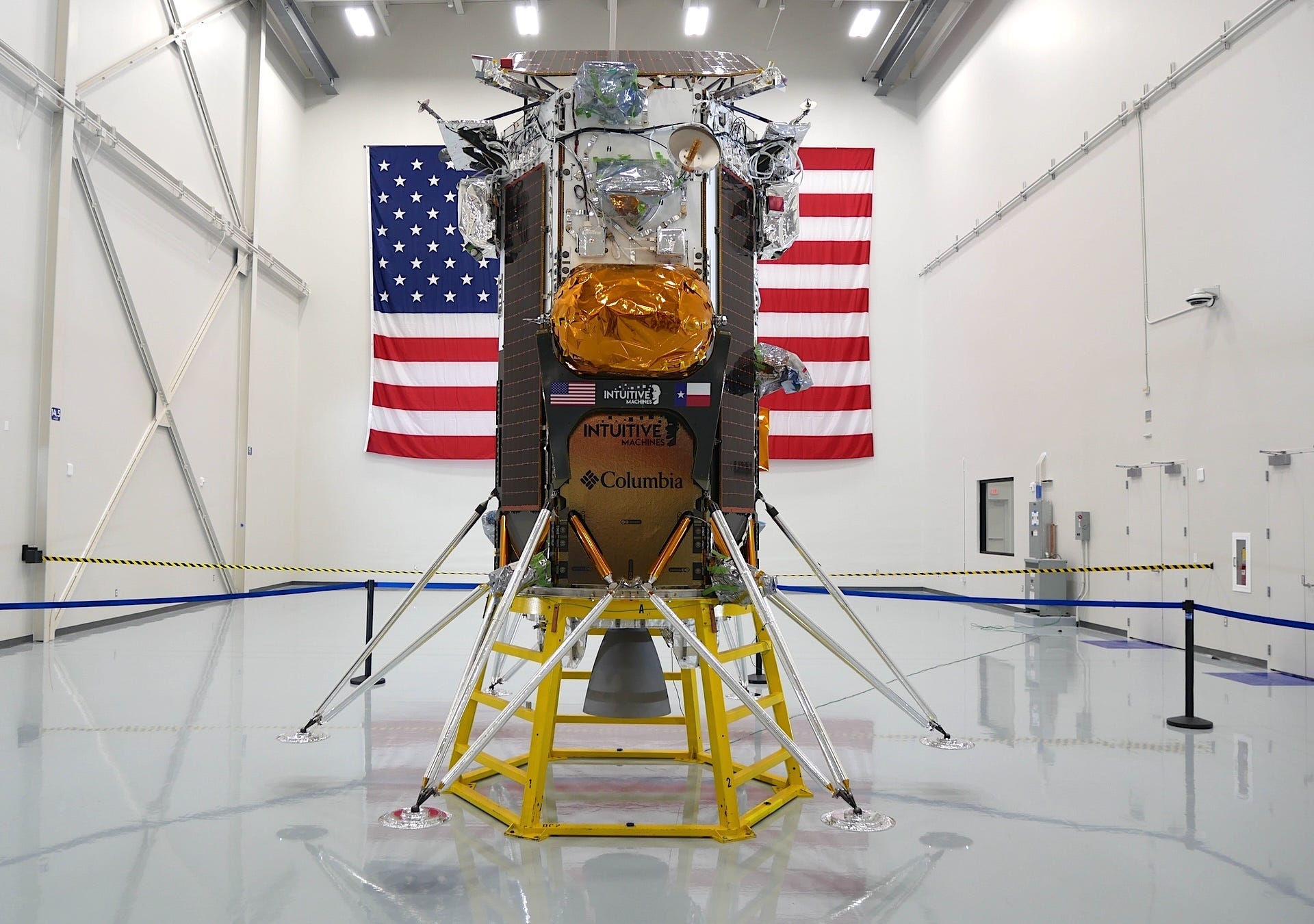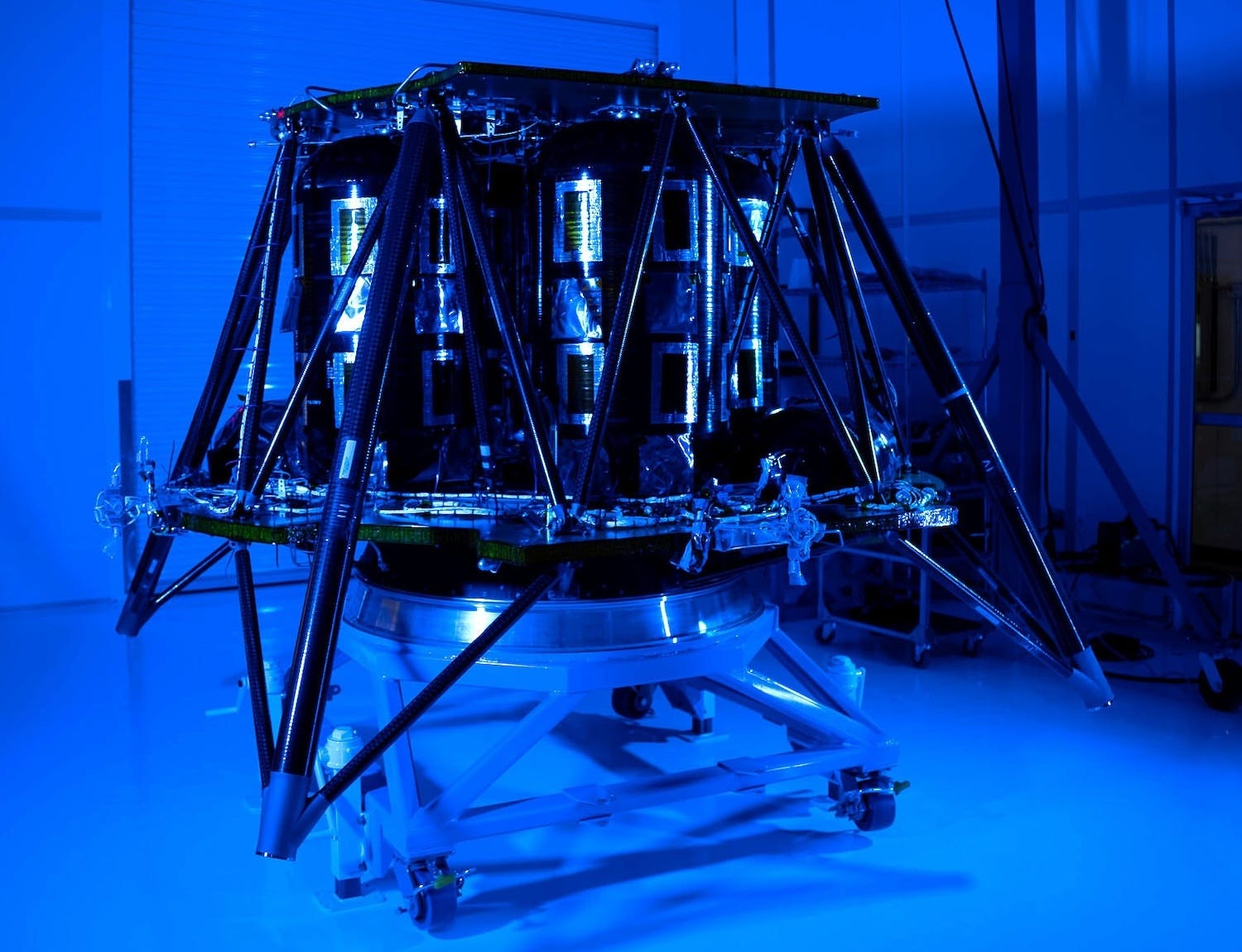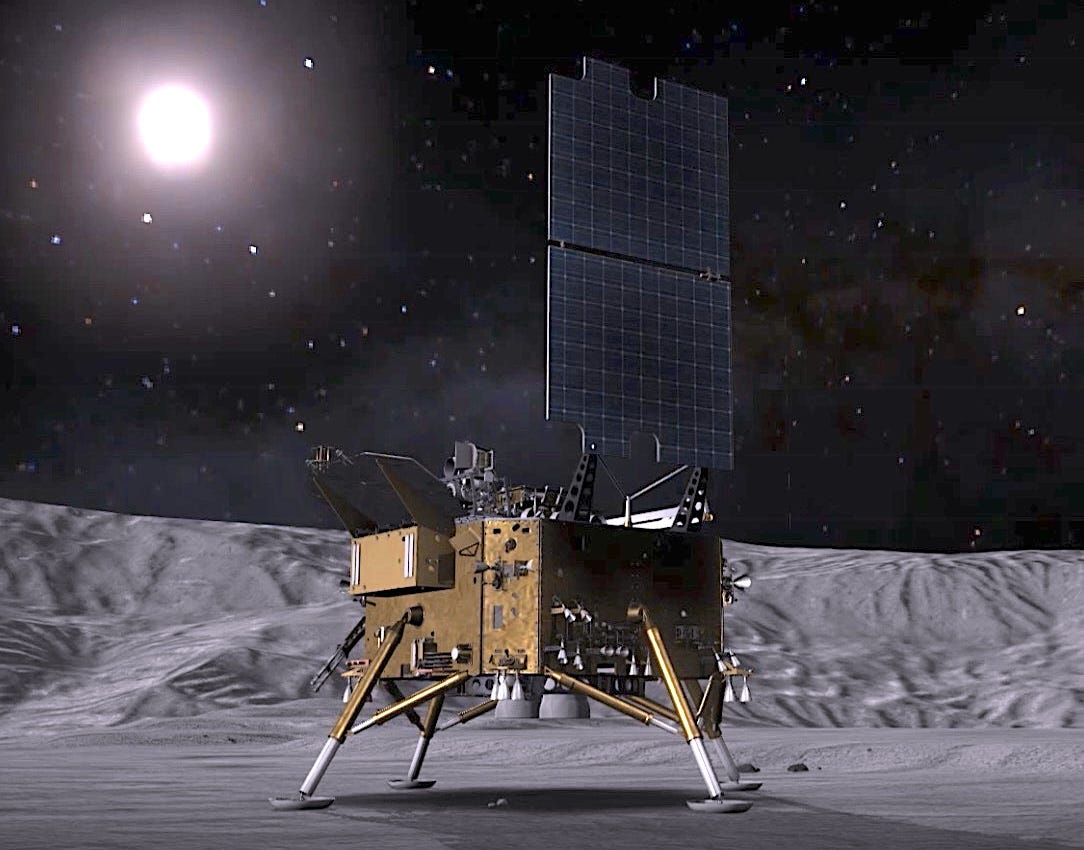Moon Monday #148: US lunar landers coming to life, China’s outlining of Chang’e 8, and more
I’m in Delhi this week to attend the Indian Space Conclave. If you’re around, get in touch to chat space, science, writing, and the Web!
Mission updates
- JAXA’s SLIM lunar lander flew 5,000 kilometers past the Moon on October 4. Andrew Jones reports that SLIM’s fuel-efficient trajectory will loop it back to the Moon end of year for orbital insertion. SLIM will then spend a month in lunar orbit before attempting its 20-minute descent and ‘pinpoint landing’.
- Intuitive Machines unveiled its completed first Moon lander called Nova-C on October 3. The company and SpaceX are targeting a five-day launch window starting November 16 on a Falcon 9 rocket. Eric Berger reports that the lander will take five to seven days to reach the Moon, after which it will spend a day lining up with its near-polar landing site of Malapert A crater at 80°S before attempting a landing. The mission, named IM-1, will carry six NASA science & technology payloads as part of the agency’s CLPS program. A separate, commercial telescope called ILO-X from Hawaii-based ILOA has been integrated into the lander.

- Roscosmos announced on its Telegram channel that the Luna 25 lander’s August 19 crash on the Moon from a 50% longer duration engine firing than necessary likely stemmed from the software not being designed to prioritize data from its accelerometer, which would’ve otherwise told it that the desired velocity change was achieved well before the engines actually shutdown.
- As Firefly gears up for its first CLPS mission in 2024 carrying 155 kilograms of NASA payloads to the Moon, the company announced on October 4 that it has completed assembling the Blue Ghost lander’s in-house-developed structure and fluid systems. Blue Ghost’s target landing site is at 18.56°N, 61.81°E in Mare Crisium. The company told me over email that Firefly has “conducted more than 100 drop tests on multiple surfaces, including lunar simulants, sand, and concrete” to qualify the lander’s structure. Firefly added that the company has created a 4,000-square-meter moonscape in Briggs, Texas to test the lander’s hazard avoidance and terrain navigation system. It’s a landing technology that proved valuable most recently for India’s Chandrayaan 3 Moon lander which performed a last-minute divert maneuver.

China offers more room for international experiments on Chang’e 8
CNSA officials revealed new details on China’s Chang’e 8 Moon landing mission at the 74th International Astronautical Congress on October 2, Andrew Jones reports. Targeting launch on a Long March 5 heavy-lift rocket in 2028, the mission will comprise a lander, a rover, and an “operation” bot to collectively explore the geology and environment at the Moon’s south pole. Crucially, Chang’e 8 will test technologies to extract and use local resources such as water ice for future mission needs, including for when Chinese crew begin landing starting end of decade. There will also be a soft X-ray telescope onboard the Chang’e 8 lander.
Notably with Chang’e 8, China is increasing the scope of international contributions by an order of magnitude in terms of mass. While Chang’e 6 launching next year will carry a good 20 kilograms of international instruments, China is accepting proposals amassing 200 kilograms for Chang’e 8 as Ling Xin reports. CNSA says these can be scientific instruments, technology payloads or even system-level contributions.

As for China’s Chang’e 7 mission, CNSA is targeting a 2026 launch. It will consist of an orbiter and a lander, the latter of which will deploy a rover and a small flying probe to explore one of some key identified landing regions on the Moon’s south pole. In much the same vein as the NASA VIPER and JAXA-ISRO LUPEX missions, the Chang’e 7 flying probe will host a drill to sample materials in permanently shadowed areas from varying depths. A mechanical arm on the probe will feed the samples into a heating furnace for the onboard Lunar Water Molecular Analyzer (LWMA) to scan it for water ice and other volatile resources such as ammonia.
As such, Chang’e 7 and Chang’e 8 will contribute heavily towards the China-led long-term scientific Moonbase on the Moon’s south pole called the International Lunar Research Station (ILRS).
Many thanks to Epsilon3, Open Lunar Foundation, Parvathy Prem and Planetary Scientist David Blewett for sponsoring this week’s Moon Monday.
The US further invests in nuclear power for Moon missions
The three companies that bagged $5 million NASA contracts each to develop autonomous, compact nuclear fission surface power system prototypes for future Artemis Moon missions have now gotten bigger, two-year contracts from the US Air Force Research Laboratory to advance the systems. Fission systems can enable hardware to operate during long and frigid lunar nights as well as inside permanently shadowed regions. They can also power and enable sustained robotic and human presence on the Moon as the technology evolves. The aforementioned three companies and the contract amounts are:
- Lockheed Martin: $33.7 million
- Westinghouse: $16.9 million
- Intuitive Machines: $9.4 million
Relatedly, as part of recent public-private Tipping Point contracts, NASA is awarding $15 million to a team led by Zeno Power to demonstrate nuclear electrical power on the Moon in 2027. The team includes CLPS vendors Blue Origin and Intuitive Machines. Also relatedly, the UK Space Agency is funding a team led by Rolls-Royce with £2.9 million to develop a lightweight and modular autonomous nuclear micro-reactor, hoping for its initial demonstration on the Moon before 2030.
More Moon
- Axiom Space is partnering with Italia luxury brand Prada to work on the outermost layer of the former’s AxEMU spacesuit. NASA competitively chose Axiom’s suits to be worn by astronauts for the crewed Artemis III Moon landing mission mid-decade. Axiom’s suits build over NASA’s own (recently shelved) xEMU suits by featuring enhanced mobility, upgraded insulation and cooling for the harsh lunar polar environment, a back hatch to climb into and close the spacesuit by oneself, a HD helmet cam, and even a light band.
- A new study, as covered by Nancy Atkinson, says that executing long-term human exploration of the Moon, like with Artemis and ILRS, will prove more challenging than expected primarily because we don’t know enough about the biomedical challenges of deep space exploration.
- New startup Starpath Robotics raised $2.5 million to get started on big plans to mine lunar water, extract liquid oxygen from it, and then sell it to companies planning to regularly operate hardware on the Moon. The latter could include, after end of decade, Blue Origin with its Blue Moon lander as well as SpaceX with its upgraded Lunar Starship.
- Sponsored listing: With Build from Epsilon3, companies like Redwire and ispace simplify their hardware manufacturing for the Moon thanks to end-to-end management of builds, parts, and inventories.
